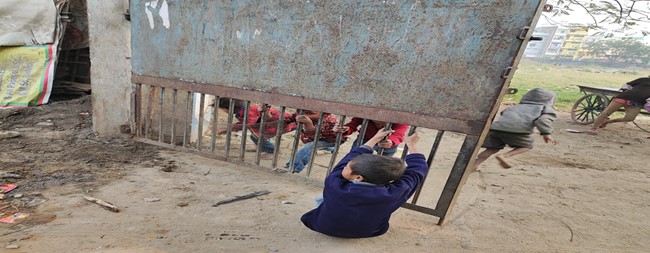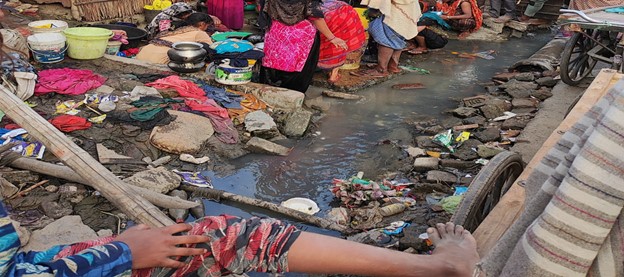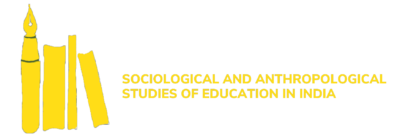Experiencing the Field: Slum as Physical Space Shaping and Producing Conflict in Mental Space
Shadab Anis
PhD Research Candidate, National Institute of Educational Planning and Administration (NIEPA)
shadab.anis@gmail.com
The central question of my PhD is to investigate how marginalisation plays out in the everyday experiences of people and children living in slums and how this affects children’s educational opportunities. To investigate the underlying socio-economic and educational status of children, the primary data was collected by conducting household surveys, interviews, and focus group discussions with slum dwellers living in selected slums of Patna.

Image 1: : Fieldwork, 2021, Bahadurpur Jhuggi Jhopri, Patna, Bihar (Photograph taken by author)
Internal Dilemmas and Contradiction
A “field” in a general sense is a plain surface, for instance, an agricultural field, a football, or a cricket ground. However, in research, I understood “field” to be a place where I was trying to make sense of people’s everyday lives, struggles, negotiations and contestations. A field for me is a home and social locations for the people there that shape their identities and I was interested to understand these social locations. I conducted my fieldwork in Patna’s urban slums from August 2021 to March 2022. Now that I have spent considerable time in the field, I believe it is vital to share some of my field experiences and moments.
Entering the field for any type of research is extremely difficult, and once completed, it provides enormous relief as well as a plethora of questions and contradictions. The difficulty is not simply with the never-ending questions in one’s mind on how to approach the fields and subjects. What lens should be used to investigate, observe, and interpret the field? Regardless of how hard I tried to be inclusive in the field in order to make the participants of my study comfortable, once face to face with them I always found myself as someone who is different. The transition from summer to winter is such a phenomenon that having a bag with a water bottle, clean and comfortable clothes and footwear makes you feel out of place. You are easily identified as an outsider. Approaching the field with such privileges creates serious inner conflicts and contradictions because of many reasons.
I selected different slums in Patna for my study since slum dwellers live in a variety of places, including on pavements, over railway tracks, in swampy areas, near river banks and drainage, near busy roads in Patna. Each slum has its own distinctive features in terms of demography, socio-economic profiles, and basic infrastructure availability. That is why it is vital to explore different types of slums, each with its unique set of challenges. The various slums and locations were chosen in order to understand and study intra-slum differences.
One visit to Ambedkar Nagar, an urban slum in Patna called Harijan Basti by its residents, made me acknowledge that the people live under destitution (Banerjee et al., 2012) anxiety and fear of the current socio-political milieu in a multi-religious environment. I chose to go into a three-story Madrasa in the center of the slum and connect with the children and the Madrasa’s head. The head of the Madrasa allowed me to interact with the children and also spoke to me about the children’s education. I briefed them about me and my research. The head commended me because I am also from the same community. I asked for his assistance in data collection, and he assured me of his support. On one of my visits, I was collecting data when an elderly Muslim woman belonging to the Bakho nomadic community inquired if I worked for the government. “Are you doing a survey for the NRC?” she asked. NRC stands for National Register of Citizenship[i].
I associated her fear, insecurities and status of citizenship with mine under the current right wing government in power at the Centre. Like her it also triggered my sense of humiliation, panic, fear, and existential crisis being a Muslim under the threat of CAA, 2019. She began yelling that I am a “government agent”. People gathered, and one young lady tore apart my nearly ten filled questionnaires. I was terrified when people began to question why I was seeking such detailed information. I replied, “No, I am a Muslim,” and displayed my identity card. Nobody believed me, so I went to the Madrasa head for assistance. The head of the Madrasa arrived and explained my work, asking the community to help me with my studies. I took a deep breath of relief and thanked myself for meeting the Madrasa head before entering the field. This helps me recognise how crucial it is to evaluate every aspect and be prepared before entering the field. People are already suffering, and they do not want to suffer any more, which seems entirely logical.

Taar Ghat, another slum located at the bank of Ganga a few minutes by walk from Gandhi Maidan at the heart of Patna, consists of around hundred semi pacca and kaccha households. The slum stretched for a kilometer and a narrow lane divides the slum in two parts. The residents shared that for the entire monsoons the water enters their houses. The people in the slum use a high wall as a path to enter their houses. This wall is constructed to prevent the water of Ganga entering the city. I encountered another setback and a new learning on this site. I decided to see how people in the slums are celebrating New Year and I wanted to interact with some of them. I entered the field and saw people, including children, well-dressed and heading towards Gandhi Maidan and Ganga Ghat to enjoy. It was winter, I talked to a few people and they said that they have cooked good food and after lunch they plan to visit some good places. One of the women was standing outside her house and I introduced myself and asked a few questions, suddenly her husband came and asked the wife what he was asking? She replied, he is doing the survey. The husband was so angry and said, “Leave! Today is New Year, don’t ruin our day.” Initially I felt bad at his rudeness but later on while reflecting on the incident, I realised that I should not have gone to the field on New Year’s day.
Talking about misery and day-to-day struggle can take an emotional toll and ruin a day when everyone is enjoying themselves. I used to think there are no boundaries or borders in the field but there is certainly the border and the border is when the people in the field find that someone is encroaching their private sphere. People who live in the margins of the city spend time just outside their home and that space is a private space. Being outside of their house should not be considered that they are in the public sphere. Being outside of their house is not always a choice and in case of slum dwellers it is a compulsion because of the space crunch in their houses. Being an outsider I understood that it is important to respect time and space in its totality. It was my fault and one of the most insightful and important lessons I have learned for my research in future.
An outsider in the slum
As I reflected on my fieldwork I realised that I used to think that my visit to the slums would not be seen as an attempt at trespassing. But can I think of roaming freely in gated communities or residential welfare colonies? Will I be welcomed by the elites the same as I was welcomed by the slum dwellers? I have realised that if anyone is having easy access it does not mean that at any time, in any circumstances, we should enter the field; like I did in entering their spaces at the time of their joy and happiness. There are people who have lost the hope that their hardship might end and that is why they do not want to share their day to day struggles with strangers. I recall yet another incident. One of the pavement dwellings called Bankipur Club, a few minutes’ walk from Gandhi Maidan, consists of thirty to forty habitations mostly tents covered with plastics and tents. Every three to four months they are displaced by the Municipal Corporation and after four- five days they return. A lady in her fifties was sitting outside her tent and I approached her. She said, “I beg you not to increase our pain and struggles. Your report will do more harm than any good and that is why I do not want to talk”. She was right, is my work going to support and address her concerns in any positive manner? Listening to their misery, deprivation and deplorable living conditions the field seems very depressing. A lot of energy is required to visit the field again and again and to continue to hope that my research will do some good to my subjects. I have returned from the field with a lot of experiences, memories, learnings and motivation.
Endnotes
[i] The Citizenship Amendment Act, 2019 makes provision of Indian citizenship available to the persecuted religious minorities such as Sikh, Buddhists, Hindus, Christians, Parsis and Jains from Muslim majority neighbouring Pakistan, Afghanistan and Bangladesh while excluding Muslims. The question is what is the rational basis of identifying persecution from only three countries? Why has it not included the persecuted Hindus and Muslims (Sri Lanka), Hazaras and Ahmadiyyas (Bangladesh and Pakistan), Rohingyas (Myanmar) and Uyghurs (China). This amendment in citizenship, cannot be seen in isolation, but must be understood in association with the National Register of Citizenship and National Population Register, which would be identifying ‘illegal immigrants’ and doubtful citizens will be sent to detention camps (E.g. Assam has gone through the process of NRC and 1.9 million citizens are marked as doubtful comprising mostly Hindu Bengalis). Now, it is a burden of people in India to prove their citizenship. The religious basis of citizenship is an attempt to delegitimize the constitutional claims of citizenship of many Muslims. It is also against the very nature of equality and secularism which is embedded in the constitution. Its discourse of citizenship has been shifted from ‘jus soli’ (by birth) to ‘jus sanguinis’ (by descent) (Chandrachud, 2020).
References:
Banerjee, A. Pande, R. and Walton, M. (2012, October). Delhi’s Slum-Dwellers: Deprivation, Preferences and Political Engagement among the Urban Poor. (Working Paper# S-5003-INC-1). International Growth Center. https://www.theigc.org/sites/default/files/2014/10/Banerjee-Et-Al-2012-Working-Paper-1.pdf
Chandrachud, A. (2020). Secularism and the Citizenship Amendment Act, Paper Presentation “India: Seventy Years of the Republic” Victoria, University of Wellington.
Govinda, R. and Bandyopadhyay, M. (2011). Access to Elementary Education in India: Analytical Overview. In R. Govinda (Eds.), Who Goes to School: Exploring Exclusion in Indian Education. Oxford University Press, pp. 1-86.
Ramanathan, U. (2006). ‘Illegality and the urban poor’, Economic and Political Weekly, 41 (29), pp. 3193-3197. https://www.jstor.org/stable/4418470
